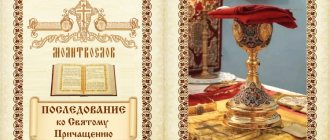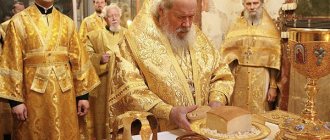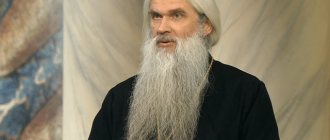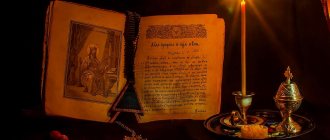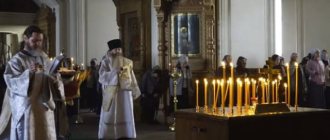"Save me, God!".
Thank you for visiting our website, before you start studying the information, please subscribe to our Orthodox community on Instagram, Lord, Save and Preserve † - https://www.instagram.com/spasi.gospodi/. The community has more than 60,000 subscribers. There are many of us like-minded people and we are growing quickly, we post prayers, sayings of saints, prayer requests, and timely post useful information about holidays and Orthodox events... Subscribe. Guardian Angel to you!
Prayer chants have always been the main and most important works of Orthodox church hymnography. From the very beginning of Christianity, the canons were written exclusively by the holy fathers, who always stood and will stand above ordinary laity in their spirituality. But it is noteworthy that these works are not always understandable to the average person, because they are imbued with special insight and theology.
However, as it is written in church laws, “every breath praises the Lord.” That is why in the 6th century, liturgical leaders began to use in their practice works that were more easily perceived by ordinary people - these were akathists. And in order to understand whether it is better to read the canon or akathist, we suggest looking into the depths of Christian history.
Types of canons
Photo: Stvladimir.by
The canons were compiled by church councils over the centuries. But there is a part of the canons that have specific authors - the apostles and authoritative, respected holy fathers.
On this basis they are divided into:
- cathedrals,
- apostolic,
- patristic.
The full existing canons can be studied in the main canonical corpus of Orthodoxy, called the Book of Rules. The second collection is “The Helmsman’s Book” - it serves as a collection of secular and ecclesiastical laws that are used by church courts in Orthodox Slavic countries. They also guide the management of the Church.
What are canon and akathist
Few believers online or people who are just entering the service of the Lord often ask the question: what is an akathist and a canon?
Akathist is one of the types of hymnography in church service, which contains praises of holidays, saints, the Most Holy Theotokos and, of course, the Lord. They begin with the word “Rejoice.” Most often, it also glorifies New Testament traditions.
A canon is also one of the types of hymnography in church services, which is the main work reflecting a holiday or saint. They often intertwine New Testament and Old Testament events.
The best article for you, go to: Akathist to Simeon of Verkhoturye
Why are church canons needed?
Photo: Hramermogen.ru
Canon is translated from Greek as “norm” or “rule”. And in their meaning they represent for the Church the same thing as their legislation represents for the state. The history of society over the course of many centuries has repeatedly shown what happens to states in which people begin to disregard the laws. Therefore, the canons of the Church sacredly sweep through millennia, changing only depending on the social structure, but at the same time without losing their foundation - the love of God.
It is not for nothing that the famous foreign theological theorist and practitioner, teacher of the subject of Canon Law in France, Russian by origin, Nikolai Nikolaevich Afanasyev, told students about this when he began a course of lectures. He began the course by declaring to the audience that law itself has no place in the Church; it appeared when love dried up! No matter how strange these words may sound from the lips of a priest, they truly reflect the trends of the world order.
Some laws and rules in everyday life sometimes seem unnecessary and tedious to us, for example, traffic rules. But as soon as even one person grossly violates the traffic rules, he can create a giant traffic jam and ruin many lives, both physically and in the social sense. The same analogy can be drawn with church canons.
But in the Church everything is much more informal on an individual level. After all, each parishioner has his own personal qualities, problems, sins that once brought him to the Church for the first time. He cannot fulfill certain canons for various reasons, for example, physical weakness. And the confessor plays a very significant role in this. It limits the canonical norm for a particular Orthodox Christian.
Many canons were formed in the first centuries after the birth of Christ and it is literally completely impossible to apply them in our time. Therefore, avoiding formalism, being flexible and taking into account the individual capabilities of the flock is the canonical duty of a priest.
Distinctive features
Many unchurched Christians are interested in the difference between a canon and an akathist. The main distinctive characteristics of the above-described genres of church hymnography include:
- The akathist, as a special church work, is distinguished by a lighter syllable and melodic pronunciation. “The Folk Song” is not only easy to read by parishioners, but also well perceived by ear.
- The canons are performed in churches almost every day, while the ritual of hymns of praise and gratitude addressed to the Most Holy Theotokos is performed by clergy only once a year. Orthodox Christians, who revere and believe in God, the Mother of God and the holy great martyrs, read akathists during morning prayer.
- When reading the canons, it is necessary to comply with the rules regulated by the church charter, which is considered optional during the performance of folk chants. There is a certain circle of weekly services, according to which works of hymnography are selected. But when reading a prayer at home, a believer can choose an ode of praise and gratitude at his own discretion.
- The “People's Prayer” begins with a proimia (introductory stanza), and the multi-stanza text has a simple beginning.
- In the canons, descriptions of Old Testament events are expropriated onto New Testament actions. As for the lyrics of songs of praise, the prayers sing about New Testament and later church events.
- Each ikos of the “folk prayer” ends with the exclamation “Rejoice,” which is uncharacteristic for a multi-stanza church work.
- In the canon, at the end of the third and sixth cantos, a small litany is read. Kontakia and ikos are read one after another, without any digressions.
- Some clergy do not recognize akathists, considering odes of praise and gratitude to be ordinary folk art that has no place in the church. This statement does not apply to the Akathist to the Most Holy Theotokos. The rest of the chants of praise and gratitude are performed mainly at home.
You need to turn to God, the Mother of God, saints and archangels sincerely and openly. Therefore, while reading the prayer, it is recommended to put aside all worldly affairs and worries.
If you find an error, please select a piece of text and press Ctrl+Enter.
Is it possible to receive salvation and eternal life if you do not follow the canonical rules?
Photo: Elitsy.ru
Each person has a lot of weaknesses - laziness, selfishness, many unconquered passions. Therefore, for each baptized person a certain vector is needed, which on the way to the main goal - salvation - will determine the shortest path. Church canons serve as such a vector of pious life.
For example, everyone can have home prayer in their own order, as long as it achieves the goal - to pray, that is, to talk with God and receive adequate feedback, to find peace of mind. Let this happen with an unlit lamp, sitting in a chair after a hard day of work. But this result will be better than that of someone who read the entire evening rule, standing in front of the icons with a lit candle, but with his thoughts wandering far from God. That is, both of them violated the canons in some way, but only one of them benefited from this.
But when these same people come to the Temple, it is no longer possible to take into account all views, interests and preferences. And here, in society, it is necessary to bring the entire mass of individuals to some kind of harmonious uniformity. Here we cannot do without canons and their implementation is necessary.
Thus, generally binding canons become necessary where there is a society, where it is necessary to clearly define the rights and responsibilities of everyone in order to avoid disorder, chaos and bring everything into a uniform form.
And this view of the One Holy Catholic Apostolic Church has remained unchanged since its founding. The canons are called upon to preserve it in the form in which Jesus Christ created it, so as not to lose the Divine essence.
The Church is identical to itself, and this has been preserved through all the past centuries.
What is the task of church canons?
The main task of church canons is the application of the unchanging and eternal infallible foundations of Christian moral teaching and ecclesiological dogmas, contained either directly or indirectly in their texts, to the changing church life. Therefore, in any canon one can find, on the one hand, rooted in the unchangeable dogmatic teaching of the Church, and on the other hand , conditioned by a historically specific situation, the circumstances of church life that took place at the time the canon was published and could subsequently change. Thus, the basis of every canon contains an unchanging, dogmatically determined moment, but in its concrete and literal sense the canon also reflects the transitory circumstances of church life.
Did Jesus Christ bequeath any canons?
Photo: Elitsy.ru
Of course, it is from Him that many canonical standards of Christian life come. For example, the very first sacrament - Baptism, He establishes in the Gospel:
Go therefore and make disciples of all nations, baptizing them in the name of the Father and the Son and the Holy Spirit, teaching them to observe everything that I have commanded you; and lo, I am with you always, even to the end of the age. Amen. Matthew 28:19-20
And many other norms that we learn from the Holy Gospel are established precisely as canons. That is, the founder of the Church himself initially gives the rules by which she should live throughout the centuries.
Of course, the Holy Spirit guides and overshadows our Church, thanks to which it develops and renews its norms, following world developments. But in general, all updates take place only according to the principles that the Lord established in the Gospel.
What is canon in fan fiction?
Fan fiction is a literary work written based on a canon in which the author became interested. The writer of such a work does not invent a world or characters, but uses ready-made images for his work.
Why do authors create works based on the biblical works of the holy fathers? This is because each chant is associated with a certain period in the history of Christianity or some biblical event. Each one feels the presence of an ancient era.
What is the Theotokos in the canons? These are prayer works in which the memory of the Blessed Virgin Mary is glorified. Here is an example of such a piece:
“Oh, blessed Virgin, Lady Theotokos! You are more precious than all the angels and archangels, and more precious than all the creatures. You are a helper for the offended, hope for the hopeless, an intercessor for the poor, joy for the poor, comfort for the poor, ironing for the ironing, clothes for the poor, healing for the sick, salvation for the sinner, help and protection for all Christians Oh, all-merciful Virgin Mary and Lady!
With your mercy, save and have mercy on our pious and Christ-loving people.
Save, Mother of God, and have mercy on your servants: our holy Synod, consecrate the metropolitans and bishops and the celestial and monastic ranks; protect this government, military commander, mayor and Christ-loving war and all Orthodox Christians through your honorable protection.
Pray, O Lady, to incarnate this without seed from you, Christ our God, let us not forget His power against our invisible and visible enemies.
Oh, all-merciful Lady Mother of God, protect yourself from sin and deliver from famine, pestilence, earthquakes and floods, from fire and sword, from invasion of other people and from civil strife, from sudden death, from enemy attack, from harmful winds, from deadly plague and all evil.
Grant, Lady, peace and health to your servants, to all Orthodox Christians, and enlighten the technical mind and kindly look at them, for they will save you.
Honor us, Thy sinful servants, from the kingdom to Thy Sin, our Christ God. For this reason, the Negovata power is blessed and glorified, since the beginninglessness of Negov the Father and from the pre-illumination, good and life-giving Spirit of Negov, this and everyone, and forever and ever. Amine."
The Lord is always with you!
The best article for you, go to: Is it possible to wear someone else’s cross?
special instructions
The parishioner must observe the rules of decency, behave sedately and calmly.
- If you are standing with a burning candle, make sure that the wax does not drip down.
- Be careful not to set the person in front on fire.
- Before coming to church, try to learn the rules of behavior in a holy place.
- It is allowed to light candles and pray for an unbaptized person, but writing his name in the church book is prohibited.
- In case of a drug problem, it is advised to place candles in front of the icon of the Mother of God, which is called the “Inexhaustible Chalice,” in front of the images of Boniface the Martyr or John of Kronstadt.
- Wax in front of the image of St. Panteleimon helps reduce the negative consequences of the upcoming operation.
- Anyone who wants to gain prosperity from the Almighty and the saints must sincerely pray and live according to the commandments. Through the Holy Gospel, God draws everyone's attention to virtue, love and humility. However, people only ask, but cannot take an independent step towards improvement.
- It is allowed to light wax candles for health or repose on any day, but prayers for the dead are not performed on Easter. The process is transferred to Radonitsa.
- Try to make a donation for the temple. The desire for help must come from the depths of the heart. Donate your finances to the poor, who can be seen in large numbers near the monasteries.
- Goodwill brings more benefit than a large sum of money donated insincerely. The Lord pays attention to a person’s spirituality, and not to his pocket. He does not condemn poverty, but instructs people to get rid of greed.
About church candles:
- Why do ministers extinguish candles in church?
- Why did the candle fall or cry?
- About Jerusalem candles
The ritual of lighting candles for health or repose is the most important means of comprehending love for the Lord. The candle symbolizes many virtuous qualities and light on the path to His abode. The duties of a believer who comes to the procession include bows, gestures of the cross and sincere prayers. By lighting candles, a person asks for prosperity, health and business success, and also honors the deceased.
History of the canon as a hymnographic genre
Canons of this kind appeared in Byzantium around the 7th century and spread quite quickly, displacing the even more extensive genre of kontakion. Initially, the canons consisted of an interweaving of nine hymns, borrowed from the Holy Scriptures, with Christian prayers. However, gradually the latter began to predominate, and biblical songs began to decline, until they were completely replaced in liturgical practice by short proclamation verses.
Tips for choosing the best option
To determine which position is best to sleep in, you should experiment a little, observe your own well-being and health. Usually the answer is prompted by intuition. Some experts argue that there is a compass inside a person that determines how and where to rest. It is recommended to adhere to the canons that apply to a particular country or religion. But if you like Eastern practice, you can safely experiment.
There is not much difference in what position you sleep. The main thing is that after sleep you feel cheerful. If you feel comfortable resting with your head to the north, then no one will forbid it.
Most Orthodox Christians wonder how to properly place candles in a church. These wax attributes emit the divine radiance that Our Savior brought to the sinful earth. Only the Son of God is able to dispel the darkness and ignorance of the common people.
Pure wax is a symbol of a person’s complete repentance for his own crimes before the world. This attribute can be a direct guide towards God’s consciousness.
Can this or that church canon not be used?
The canon may become inapplicable due to the disappearance of the church institution that it regulates. For example, Chalcis. 15 determines the age limit for becoming a deaconess - 40 years. With the disappearance of the order of deaconesses, the rule ceased to apply. Nevertheless, it remained in the canonical corps. Moreover, it now contains a certain ecclesiological principle, which has not lost its practical significance due to the disappearance of the institution of deaconesses. For example, it can serve as a starting point in the reasoning of church authorities about establishing an age limit for appointing women to any church positions. Some canons have the character of private definitions, and therefore, according to the literal text, they are not applicable in any other cases except those for which they were published, such as II Omni. 4 (“About Maximus Cynicus, and about the outrage he caused in Constantinople...”).
History of tradition
For most people, any church is associated with lighting a fire. When Christianity was just emerging, secret meetings, which were hidden from persecution in catacombs and dungeons, were illuminated only by oil lamps.
Fire was often used in paganism. The use of such products in worship was first mentioned in the pages of the life of the martyr Cyprian.
The state of affairs changed radically under Constantine, when Christian rituals began to penetrate Roman culture. Gradually, candles acquired the status of a permanent attribute in divine services. From the 4th century they are lit near the bodies of the dead; they were also accompanied on their “last journey.” In the 5th century, candles were used everywhere.
The candle has its own symbolism:
- Soft and pliable wax was always associated by the founders of the Orthodox Church with a soul melting with repentance.
- It symbolizes obedience to the will of the Almighty Father.
- Wax has good plasticity, this demonstrates how the human soul is naturally reborn in Jesus Christ, the Head of the Church.
- The fire on the candle openly symbolizes warm hope in serving God.
Which way should you sleep with your head?
Different peoples have their own opinions regarding which direction to fall asleep, where to place the bed, and in what position to wake up.
From a scientific point of view
Scientists at the University of Missouri have proven in their work that people who sleep with their heads facing east fall asleep worse and wake up earlier. Those who want to fill their body with energy and have a good rest are recommended to lay their heads to the north. As for other scientific works, their goal is to determine the position of the entire body during night rest. Scientists clearly recommend sleeping on your side, but which one exactly is still being debated.
According to the Orthodox
For Orthodox Christians there are no prohibitions or advice on how to sleep properly. Religion rejects superstitions, all kinds of sciences and practices like Feng Shui. A Christian should be more concerned about the state of the soul rather than the body. But the Orthodox believe that you cannot sleep when the sun sets, and it is also forbidden to place your bed opposite the door. It is recommended to place your head towards the window, but do not place your legs towards the door. The deceased is placed in this position in the coffin, and this is how they take him out of the house. Sleeping in this position is a bad sign, foreshadowing trouble.
According to the teachings of Feng Shui
Taoist practice studies effective methods of attracting good luck, prosperity, prosperity, love and health to the home. If all things in the house are put in their places, then complete harmony will begin in life. Proper arrangement of the bedroom ensures good sleep. Feng Shui recommends organizing your space correctly.
Science divides the space of the house and people into two types - Western and Eastern. What type a person belongs to must be calculated using a certain formula. With this in mind, he needs to sleep in the direction he belongs to.
In addition, you should adhere to certain rules regarding head position:
- do not fall asleep with your feet in the direction of the door;
- do not sleep with your head towards the windows;
- Do not place your sleeping place in front of a mirror.
If you follow these rules, then it becomes unclear where to put the bed and how to fall asleep on it. Feng Shui sources indicate that in the cold season it is better to sleep with your head to the north, and in the warm season - to the east. Creative people should lay in the direction of the west, careerists - in the south.
Ayurvedic interpretation
Ayurveda came to us from India. She helps to improve, tells how to acquire internal and external harmony. The technique is intertwined with the teachings of yoga. Ayurveda provides the correct nutritional system, tells you how best to relax and where. The Vedas recommend sleeping with your head facing east. However, you should not sleep in the kitchen or store food in the bedroom. To get a good night's sleep, there must be a flow of fresh air into the room.
Yogis claim that energy associated with the Universe constantly circulates in the human body. It forms a biofield, which is very easy to damage through wrong actions or actions. Energy circulates from south to north, that is, from head to feet. Therefore, in order to enter into harmony with the Universe and replenish energy reserves, you should sleep with your head facing the northeast. Otherwise, a person will lose strength during sleep.
According to Vastu followers
Indian science is studying how to attract positive energy into the home and direct the flow in the right direction. According to Vastu teachings, an apartment or house is divided into several sectors.
In each of them, certain processes occur that are responsible for one or another aspect of human life, health, and well-being:
- The eastern sector influences social activity, creativity, and prosperity. Energy is replenished thanks to the Sun.
- The northern sector is under the patronage of Mercury. Business, studies, intelligence, finances, partners and guests are in his power.
- The northeast is considered the most important sector in the house. It is run by Jupiter. In this zone you cannot swear, make trouble, start or even think about doing bad things.
- The southeastern sector is responsible for love, harmony, and mutual understanding. Venus patronizes him.
- South. This part of the house is under the protection of Mars. Here it is better to play sports, make plans, and start implementing your plans.
- The southwest is responsible for dreams and desires. Everything here happens secretly. Experts call it severe.
- The western part of the apartment is under the influence of Saturn. It is recommended to arrange work rooms and places for training here.
- The North-West is ruled by the Moon. She is responsible for the birth of children, favorable changes, and travel. Whether it is worth setting up a bedroom in this place, there is no definite answer. Whoever did this travels a lot and is practically never at home.
A person’s well-being, health and success in life depend on where he rests, works, receives guests, and also on the position of his head during sleep:
- East. Attracts harmony, is responsible for self-development, and activates potential.
- South. Strengthens health, prolongs life.
- West. Makes a person selfish and narcissistic.
- North. Adds rigidity, commercialism, selfishness.
Some Vastu followers say that you should not sleep with your head facing north, northeast, northwest. A person wastes even more energy and does not regain strength during rest. However, if you have low self-esteem, too soft a character and defenselessness, you need to go to bed in the northern part of the house and head in this direction.
In addition, there are some other recommendations regarding the position of the head according to the cardinal directions:
- the northeast will help you find your purpose in life and make the right decision;
- the north-west gives good sleep and recovery;
- the southeast will relieve nervous worries, complexes, and fears;
- the southwest will help you find harmony.
The west side is suitable for creative people.
As the ancient Slavs believed
Our ancestors considered the door to be the entrance to the afterlife. For a living person, it does not pose a danger while awake, but for a sleeping person, having his feet towards the passage is harmful. During sleep, the soul leaves the body and may walk through a doorway and not return. Hence the tradition of carrying the dead feet first. In Rus' they strictly adhered to this rule. Currently, the old traditions are almost forgotten.
According to Muslims
Sleeping with your head facing north is a bad omen! This is what Islam says. A Muslim should go to bed anywhere with his head facing east or south. The direction of southeast is allowed. It is necessary to sleep on your side and back, but do not roll over onto your stomach. The requirements are the same for women and men. Muslim people consider it a good sign to have a low bed or sleep on the ground.
Does a layman need to know the norms of church law?
I think it is necessary. Knowledge of the canons helps to understand what rights and responsibilities he has. In addition, church canons are also very useful in everyday life.
For example, the life of a newborn baby hangs by a thread and he urgently needs to be baptized. Can the mother herself do this in the maternity hospital, and if she can (and in fact this is the case), how can she do it correctly so that the sacrament of Baptism actually takes place? Or you were invited to become a godfather. What does this mean from a canonical point of view, what responsibilities do you have? Many complex issues are associated with the sacrament of Marriage. For example, is it possible, from a canonical point of view, to marry a non-Orthodox person?

